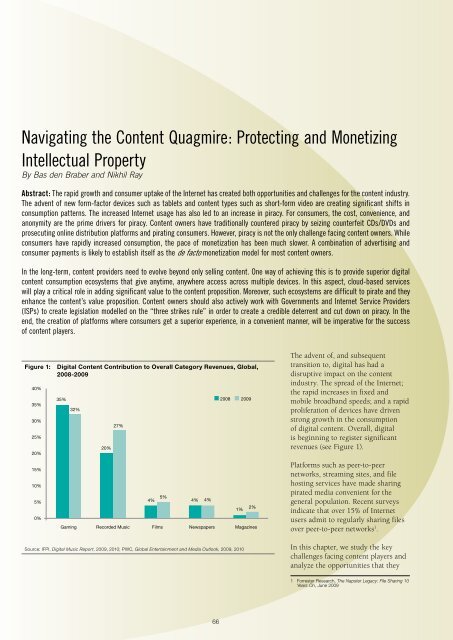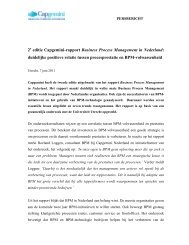IT transformations - Capgemini Consulting Nederland
IT transformations - Capgemini Consulting Nederland
IT transformations - Capgemini Consulting Nederland
You also want an ePaper? Increase the reach of your titles
YUMPU automatically turns print PDFs into web optimized ePapers that Google loves.
Navigating the Content Quagmire: Protecting and Monetizing<br />
Intellectual Property<br />
By Bas den Braber and Nikhil Ray<br />
Abstract: The rapid growth and consumer uptake of the Internet has created both opportunities and challenges for the content industry.<br />
The advent of new form-factor devices such as tablets and content types such as short-form video are creating significant shifts in<br />
consumption patterns. The increased Internet usage has also led to an increase in piracy. For consumers, the cost, convenience, and<br />
anonymity are the prime drivers for piracy. Content owners have traditionally countered piracy by seizing counterfeit CDs/DVDs and<br />
prosecuting online distribution platforms and pirating consumers. However, piracy is not the only challenge facing content owners. While<br />
consumers have rapidly increased consumption, the pace of monetization has been much slower. A combination of advertising and<br />
consumer payments is likely to establish itself as the de facto monetization model for most content owners.<br />
In the long-term, content providers need to evolve beyond only selling content. One way of achieving this is to provide superior digital<br />
content consumption ecosystems that give anytime, anywhere access across multiple devices. In this aspect, cloud-based services<br />
will play a critical role in adding significant value to the content proposition. Moreover, such ecosystems are difficult to pirate and they<br />
enhance the content’s value proposition. Content owners should also actively work with Governments and Internet Service Providers<br />
(ISPs) to create legislation modelled on the “three strikes rule” in order to create a credible deterrent and cut down on piracy. In the<br />
end, the creation of platforms where consumers get a superior experience, in a convenient manner, will be imperative for the success<br />
of content players.<br />
Figure 1:<br />
40%<br />
35%<br />
30%<br />
25%<br />
20%<br />
15%<br />
10%<br />
5%<br />
0%<br />
Digital Content Contribution to Overall Category Revenues, Global,<br />
2008-2009<br />
35%<br />
32%<br />
20%<br />
27%<br />
4%<br />
Gaming Recorded Music Films Newspapers Magazines<br />
5%<br />
4% 4%<br />
2008 2009<br />
1% 2%<br />
The advent of, and subsequent<br />
transition to, digital has had a<br />
disruptive impact on the content<br />
industry. The spread of the Internet;<br />
the rapid increases in fixed and<br />
mobile broadband speeds; and a rapid<br />
proliferation of devices have driven<br />
strong growth in the consumption<br />
of digital content. Overall, digital<br />
is beginning to register significant<br />
revenues (see Figure 1).<br />
Platforms such as peer-to-peer<br />
networks, streaming sites, and file<br />
hosting services have made sharing<br />
pirated media convenient for the<br />
general population. Recent surveys<br />
indicate that over 15% of Internet<br />
users admit to regularly sharing files<br />
over peer-to-peer networks 1 .<br />
Source: IFPI, Digital Music Report, 2009, 2010; PWC, Global Entertainment and Media Outlook, 2009, 2010<br />
In this chapter, we study the key<br />
challenges facing content players and<br />
analyze the opportunities that they<br />
1 Forrester Research, The Napster Legacy: File Sharing 10<br />
Years On, June 2009<br />
66
















